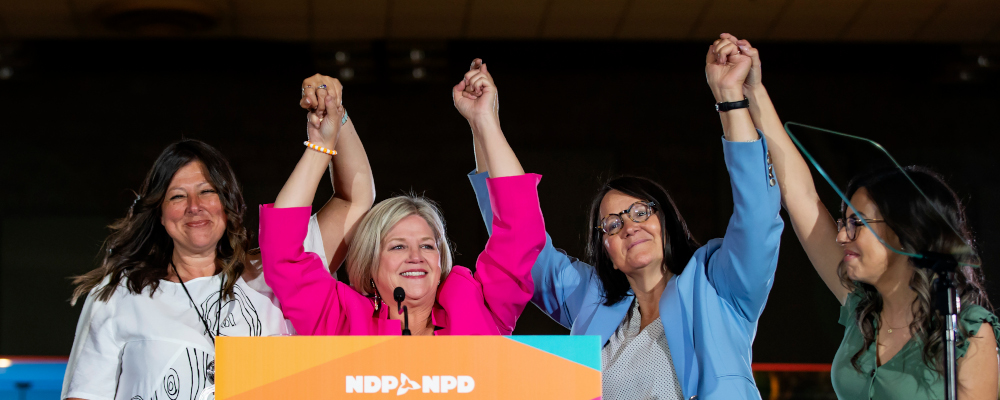There’s been a lot of focus in recent years on boosting the political participation of younger Canadians who tend to vote far less than older cohorts. One group that’s been involved in trying to engage these younger voters is CIVIX,“Since 2003, CIVIX has provided authentic learning opportunities to help millions of school-aged youth develop the habits of active and informed citizenship.” https://civix.ca/home/ a civic education non-profit organization, which, among other things, has since 2003 held parallel student votes during federal and provincial elections for high school, middle school, and elementary school students.
These educational programs give students an opportunity to learn more about Canadian policy and politics and ultimately cast a ballot in their respective ridings. CIVIX then releases the outcomes of their Student Vote initiatives in advance of the actual election.
In the context of last week’s Ontario provincial election, CIVIX held its own Student Vote Ontario with students voting in all of Ontario’s 124 electoral districts. More than 250,000 students from more than 1,600 schools ultimately participated.Ontario students elect NDP majority government in province-wide vote https://civix.ca/ontario-students-elect-ndp-majority-government-in-province-wide-vote/ The results are interesting.
To put them in context, it’s worth starting with the last provincial election in 2018. At that time, the New Democratic Party, led by Andrea Horwath, won the Student Vote election even though it finished second in the actual election outcome. The Progressive Conservative Party, led by Doug Ford, finished second among the students. The Liberal Party and the Green Party finished third and fourth respectively. In other words, Ontario students felt there was a need for change but disagreed with the broader voting public on which party ought to lead such a political change.
This year, Ontario students again diverged from voting Ontarians. The NDP once again won the Student Vote, earning 29 percent of the popular vote and winning 75 ridings to form a majority government. The Liberal Party, led by Steven Del Duca, won 22 percent of the popular vote and 28 seats. The Progressive Conservatives, once again led by Premier Doug Ford, only won 18 percent of the popular vote and 17 seats. The Green Party, led by Mike Schreiner, won 16 percent of the popular vote and four seats.
These student results obviously diverge from the actual election outcomes. Readers will know that the Progressive Conservatives were re-elected with 40.8 percent of the popular vote and 83 seats.‘A mandate for what?’: The Hub Roundtable breaks down Doug Ford’s big victory, as well as our increasing economic woes https://thehub.ca/2022-06-03/a-mandate-for-what-the-hub-roundtable-breaks-down-doug-fords-big-victory-as-well-as-our-increasing-economic-woes/ The NDP was returned as the Official Opposition, obtaining 23.7 percent and winning 31 seats. The Liberals, who won 23.8 percent of the popular vote and eight seats, as well as the Greens, who won 6 percent of the popular vote and one seat, followed from a distance.
What does this gap between the student results and the actual outcomes tell us? Younger Ontarians like the NDP. The party has consistently done exceptionally well in CIVIX’s Student Vote Ontario, dating back to the early 2010s. The NDP came in a close second behind the Liberals in 2014 and won in 2011, occupying the same 26 percent popular vote share each year.
Conservative ideas are seemingly not as popular among students as with adults of voting age. The Progressive Conservative Party was less attractive to young people in the recent election as it was down 8 percentage points on the popular vote between the 2018 and 2022 Student Vote Ontario.
It’s difficult to know the long-run implications of the results. Of course, as our students age and face a wider variety of politically charged issues, minds and voting patterns are subject to change. But it’s a good thing that CIVIX’s program is engaging young Canadians in the political process. The most important long-run outcome isn’t about partisanship but rather that students become active and engaged citizensLast week’s Ontario election featured the province’s lowest-ever voter turnout. Results from Elections Ontario show that only about 43 percent of Ontarians 18 years and older voted. This is down from 57 percent four years ago.—including participating in future elections.
Recommended for You

Derrick Hunter: Don’t blame Alberta for the cracks in Team Canada

Need to Know: Canada breathes a sigh of relief as Trump forgoes tariffs—for now

‘Hopes and fears’: The Hub reacts to President Trump’s inauguration and what it means for Canada

Howard Anglin: The courts must stay out of the politics of prorogation




